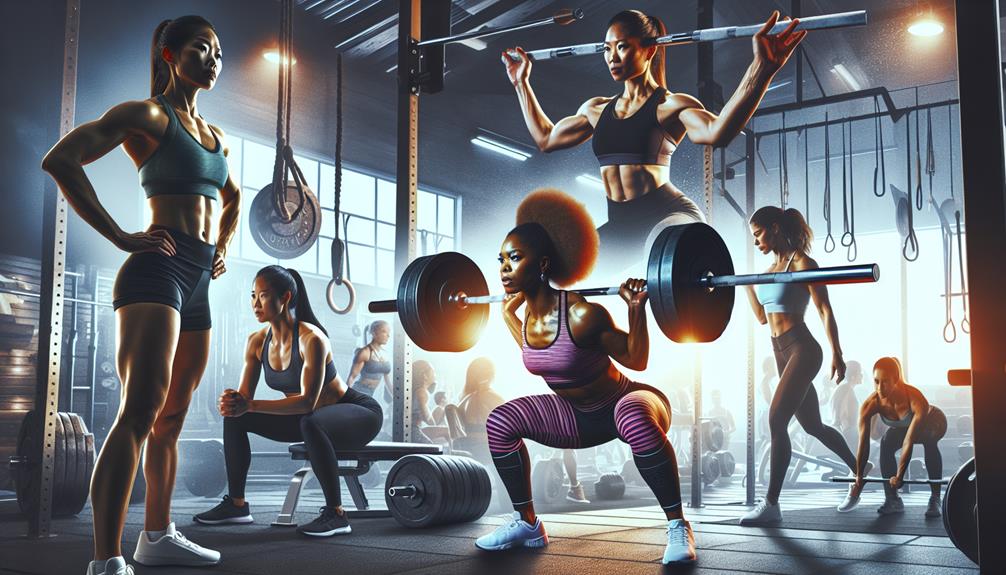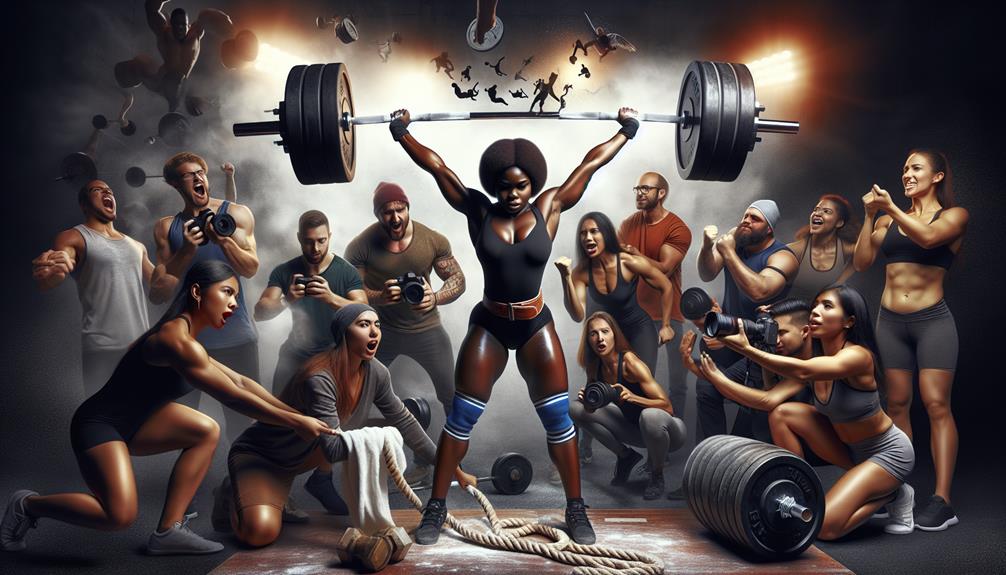So, you think lifting weights is just for men? Well, think again. Powerlifting programs for women are on the rise, and they are here to empower you and unleash your inner strength. Gone are the days when women were confined to the cardio section of the gym, sweating it out on the elliptical. It's time to challenge the status quo and embrace the powerlifting revolution. But before you jump into the world of heavy weights and barbells, there are a few things you need to know. Get ready to discover the benefits, choose the right program, master essential exercises, and overcome the challenges that come with powerlifting. Stay tuned, because you're about to embark on an empowering journey that will transform not just your physique, but your mindset too.
Benefits of Powerlifting for Women
Powerlifting offers numerous benefits for women, empowering them to build strength, increase muscle mass, and enhance overall physical performance. However, the benefits of powerlifting go beyond just physical gains. Engaging in this form of strength training can have a positive impact on your mental health and body confidence.
When you participate in powerlifting, you challenge yourself both physically and mentally. The intense training and discipline required help to build mental resilience and improve your overall mental well-being. Powerlifting pushes you to set goals, overcome obstacles, and develop a strong mindset. As you see progress in your lifts and witness your strength increasing, you gain a sense of accomplishment and confidence that can positively impact other areas of your life.
In addition to the mental benefits, powerlifting also has a significant impact on body confidence. Through consistent training, you will notice changes in your physique. Powerlifting helps to increase muscle mass and decrease body fat, resulting in a more toned and sculpted appearance. As you become stronger and more confident in your physical abilities, you will naturally feel more comfortable and proud of your body.
Choosing the Right Powerlifting Program
To make the most of your powerlifting journey, it is crucial to select a program that aligns with your goals and abilities. The right powerlifting program can make a world of difference in your training and help you achieve your desired results. Here are some key factors to consider when it comes to program selection and training intensity:
1. Goals:
- Determine your specific goals, whether it's increasing overall strength, improving technique, or preparing for a competition.
- Identify programs that are designed to target those goals and provide the necessary training methods and exercises.
2. Abilities:
- Assess your current fitness level, strength, and experience in powerlifting.
- Look for programs that cater to your abilities, offering progressions and modifications to suit your needs.
3. Training Intensity:
- Consider the level of intensity you are comfortable with and willing to commit to.
- Choose a program that challenges you while still allowing for proper recovery and injury prevention.
4. Variation and Periodization:
- Look for programs that incorporate a variety of exercises and training techniques to prevent boredom and plateauing.
- Consider programs that follow a structured periodization plan, gradually increasing intensity and volume over time.
Essential Powerlifting Exercises for Women

When it comes to building strength and achieving your powerlifting goals, incorporating essential exercises into your training routine is key. Not only will these exercises help you develop strength and power, but they will also improve your overall performance and help prevent common powerlifting injuries. So, let's dive into some of the essential powerlifting exercises for women.
First on the list is the squat. Squats are a compound exercise that targets multiple muscle groups, including your quads, hamstrings, and glutes. It is important to focus on proper form and gradually increase the weight to avoid injury. Next, we have the deadlift, which is a great exercise for developing lower body strength and building a strong back. Like the squat, maintaining proper form is crucial to prevent injuries.
Moving on to the bench press, this exercise primarily targets the chest, shoulders, and triceps. It is essential to use a spotter and start with lighter weights before progressing to heavier loads. Lastly, we have the overhead press, which targets the shoulders, triceps, and upper back. This exercise helps improve upper body strength and stability.
Incorporating these essential powerlifting exercises into your training routine, along with proper warm-up and recovery, will help you build strength, improve performance, and reduce the risk of common powerlifting injuries. Don't forget to invest in appropriate powerlifting equipment for women, such as weightlifting belts, wrist wraps, and knee sleeves, to provide support and protect your joints during heavy lifts. Stay determined, stay focused, and embrace the power within you.
Nutrition and Recovery Tips for Powerlifters
For optimal performance and recovery in powerlifting, fueling your body with the right nutrients and implementing effective recovery strategies is essential. Here are some nutrition tips and recovery strategies to help you maximize your powerlifting gains:
- Nutrition Tips:
- Eat a balanced diet: Ensure you're getting a good mix of carbohydrates, proteins, and fats to fuel your workouts and promote muscle growth.
- Prioritize protein intake: Protein is crucial for muscle repair and growth. Aim for around 1 gram of protein per pound of body weight.
- Stay hydrated: Drink plenty of water throughout the day to maintain optimal performance and aid in recovery.
- Time your meals: Eat a balanced meal containing carbohydrates and protein within 1-2 hours before your workout to provide energy and support muscle repair.
- Recovery Strategies:
- Get enough sleep: Aim for 7-9 hours of quality sleep each night to allow your body to repair and recover.
- Incorporate active recovery: Engage in low-intensity activities, such as walking or stretching, on rest days to promote blood flow and aid in muscle recovery.
- Use foam rolling and stretching: These practices can help alleviate muscle soreness and improve flexibility.
- Listen to your body: Pay attention to any signs of overtraining or injury and give yourself adequate rest when needed.
Overcoming Challenges in Powerlifting

Overcoming challenges in powerlifting requires perseverance and a strategic approach to pushing your limits and achieving your goals. Mental toughness plays a crucial role in powerlifting, as it allows you to stay focused, motivated, and resilient in the face of difficulties. When you hit a plateau or encounter setbacks, it's important to remind yourself of your inner strength and keep pushing forward. Believe in yourself and your ability to overcome any obstacles that come your way.
Another challenge in powerlifting is the risk of injury. To prevent injuries, it's essential to prioritize proper form and technique. Take the time to learn and practice the correct lifting techniques for each exercise. It's also important to listen to your body and not push yourself beyond your limits. Gradually increase the weight and intensity of your workouts to give your body time to adapt and prevent overuse injuries.
Incorporating injury prevention exercises, such as mobility drills and stability exercises, into your training routine can also help reduce the risk of injuries. Additionally, make sure to warm up properly before each workout and cool down afterward to minimize muscle soreness and stiffness.
Frequently Asked Questions
Are There Any Age Restrictions for Participating in Powerlifting Programs for Women?
There are no age restrictions for participating in powerlifting programs for women. Powerlifting can benefit women of all ages, helping them build strength and confidence at every stage of life. So, go ahead and lift those weights!
How Long Does It Typically Take to See Noticeable Strength Gains From Powerlifting?
You'll start seeing noticeable strength gains from powerlifting when you train consistently over a period of time. The timeframe can vary depending on individual factors, but with dedication and hard work, progress will come. Keep pushing yourself!
Can Powerlifting Help Improve Body Composition and Promote Weight Loss?
Powerlifting can help you improve body composition and promote weight loss. By focusing on strength training, powerlifting helps build muscle, which increases your metabolism and burns more calories. It's a powerful tool for women looking to transform their bodies.
Is It Necessary to Take Supplements in Order to Excel in Powerlifting?
You don't have to rely on supplements to excel in powerlifting. With proper training and nutrition, you can achieve great results. Focus on whole foods and listen to your body's needs. Stay dedicated and determined, and you'll see progress.
Are There Any Specific Clothing or Equipment Requirements for Powerlifting Programs for Women?
In powerlifting programs for women, there are specific clothing and equipment requirements. Clothing should be comfortable and allow for full range of motion. Equipment like weightlifting belts and wrist wraps can provide support and prevent injury.
Conclusion
Congratulations, you've taken the first step towards a stronger, more empowered you! Remember, powerlifting is not just for men, it's for women too. Did you know that studies have shown that women who engage in powerlifting programs experience a 60% increase in overall strength? Just imagine the feeling of conquering new personal records and pushing your limits. So, embrace the challenge, find the right program, and let your strength soar. You've got this!













